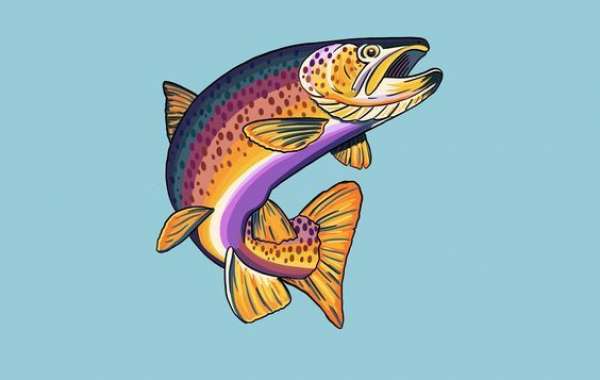Trout and salmon are two of the most popular fish for culinary and sporting purposes, but they’re often confused due to their similarities. While both belong to the same family, Salmonidae, they have distinct characteristics that set them apart in terms of taste, nutritional value, habitat, and appearance. Whether you’re deciding what to cook for dinner trout vs salmon or preparing for a fishing trip, understanding these differences can help you make an informed choice.
Habitat and Species
Salmon are primarily known for their anadromous lifestyle, meaning they are born in freshwater, migrate to the ocean, and return to freshwater to spawn. Common types of salmon include Atlantic salmon, Chinook, Coho, and Sockeye. Each has slightly different migratory patterns and can be found in both the Pacific and Atlantic Oceans, as well as rivers that feed into them.
Trout, on the other hand, are generally freshwater fish, although some species, like the steelhead trout, are also anadromous. Common types of trout include rainbow trout, brown trout, brook trout, and lake trout. They thrive in rivers, lakes, and streams across the world, especially in North America and Europe.
Appearance
At first glance, trout and salmon might look quite similar, but there are visual distinctions.
Salmon are typically larger, with some species like the Chinook salmon reaching up to 100 pounds. Their coloration varies, but they often have a silvery-blue hue, especially in the ocean. As they return to freshwater to spawn, their colors may change to red, pink, or orange, depending on the species.
Trout are generally smaller, averaging between 1 to 5 pounds, though lake trout can grow significantly larger. They often have vibrant, colorful spots and can vary in shade from silvery-blue to green, brown, or even golden hues, depending on their habitat. Rainbow trout, for example, are known for the iconic pink stripe along their sides.
Taste and Culinary Uses
When it comes to flavor, both fish are highly regarded but offer different experiences.
Salmon is richer and oilier, making it an excellent choice for grilling, smoking, or baking. Its bold flavor pairs well with a variety of herbs and sauces, and its high fat content gives it a melt-in-your-mouth texture when cooked properly. Due to this richness, salmon is often considered the more indulgent option, especially in dishes like sushi or smoked salmon spreads.
Trout has a milder, more delicate flavor, which makes it a versatile option for lighter dishes. It's less oily than salmon but still provides a good amount of healthy fats. Trout can be grilled, baked, or pan-fried and is often paired with simple ingredients like lemon and fresh herbs to highlight its natural taste. Rainbow trout, in particular, is popular for its light, slightly sweet flavor.
Nutritional Value
Both trout and salmon are packed with nutrients, making them excellent choices for a healthy diet.
Salmon is renowned for its high omega-3 fatty acid content, which is essential for heart health and reducing inflammation. It’s also a great source of protein, vitamins B12, D, and selenium. Due to its fat content, salmon tends to provide more calories per serving compared to trout.
Trout is also a fantastic source of omega-3s, though slightly less fatty than salmon. It provides a similar range of vitamins and minerals, including vitamin B12, niacin, and phosphorus, while being lower in calories. For those looking for a leaner option, trout is a great alternative without sacrificing nutritional benefits.
Fishing and Sporting Value
Both salmon and trout are highly prized by anglers for their sport and challenge.
Salmon fishing, particularly during their spawning runs, is a major event in many parts of the world. Catching a large salmon requires skill and strength, making it a favorite among sport fishers. The thrill of reeling in a powerful fish like the Chinook or Coho is unmatched for many.
Trout fishing, while less intense in terms of size, is beloved for the tranquility and technique involved. Fly fishing for trout, especially in scenic mountain streams, is a popular pastime. The challenge often lies in the precision and patience required to lure these fish, rather than the sheer power of the catch.
Sustainability
When it comes to sustainability, both wild and farmed varieties of trout and salmon are available, but there are some concerns.
Wild salmon populations, particularly in the Pacific, have faced challenges due to overfishing, habitat loss, and climate change. Farmed salmon has become a more accessible option, but not all farms follow sustainable practices, with concerns about pollution and disease.
Trout farming, particularly rainbow trout, tends to have a smaller environmental footprint compared to salmon farming. Wild trout populations are also more stable, though certain species, like brook trout, are sensitive to environmental changes.
Conclusion
Whether you prefer the bold richness of salmon or the delicate flavor of trout, both fish offer unique culinary and sporting experiences. Salmon may be the go-to for hearty meals and rich omega-3s, while trout provides a leaner, more subtle taste. Understanding the differences between these two can help you make the best choice based on your needs and preferences, whether you’re planning your next meal or your next fishing trip.




